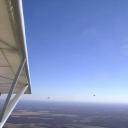Yahoo Answers is shutting down on May 4th, 2021 (Eastern Time) and beginning April 20th, 2021 (Eastern Time) the Yahoo Answers website will be in read-only mode. There will be no changes to other Yahoo properties or services, or your Yahoo account. You can find more information about the Yahoo Answers shutdown and how to download your data on this help page.
Trending News
Why does the EF scale have a lower bound on EF0?
The original Fujita scale had a mathematical 12-level relationship to the Beaufort scale and the speed of sound, and hence had an upper limit on F5 of 318 mph, where greater winds would correspond to a hypothetical F6 rating.
The enhanced Fujita scale enforces six rating levels and leaves the upper limit of tornado winds for EF5 open, yet it displays 65 mph as a lower wind speed bound for an EF0. Why? Even if you say that wind speed is inferred from damage and hence the scale is primarily a damage scale, 58 mph is the criterion for severe thunderstorm winds. In fact, I believe there was an EF0 tornado in Iowa recently whose peak winds were estimated at only 60 mph. In any case, damage is used as an indicator of intensity out of necessity, where if we had a choice we would rate a tornado based on its actual wind speeds, and then partition wind speeds into levels based on the damage they can potentially produce.
What are the weakest peak winds thought to be produced by a tornado (attached to a cloud base)?
1 Answer
- TQLv 78 years agoFavorite Answer
Your questions and many more about Fujita were addressed in 2004 by the WIND SCIENCE AND ENGINEERING CENTER at Texas Tech University in Lubbock, Texas.
You'll likely find the paper _A Recommendation for an ENHANCED FUJITA SCALE (EF-Scale)_ an interesting read...
http://www.spc.noaa.gov/faq/tornado/ef-ttu.pdf
---
"In any case, damage is used as an indicator of intensity out of necessity, where if we had a choice we would rate a tornado based on its actual wind speeds, and then partition wind speeds into levels based on the damage they can potentially produce."
Problem is...there's seldom instrumentation in place where a tornado is observed and if there was...in all likelihood...it would be destroyed by wind forces.
Source(s): Meteorologist.




